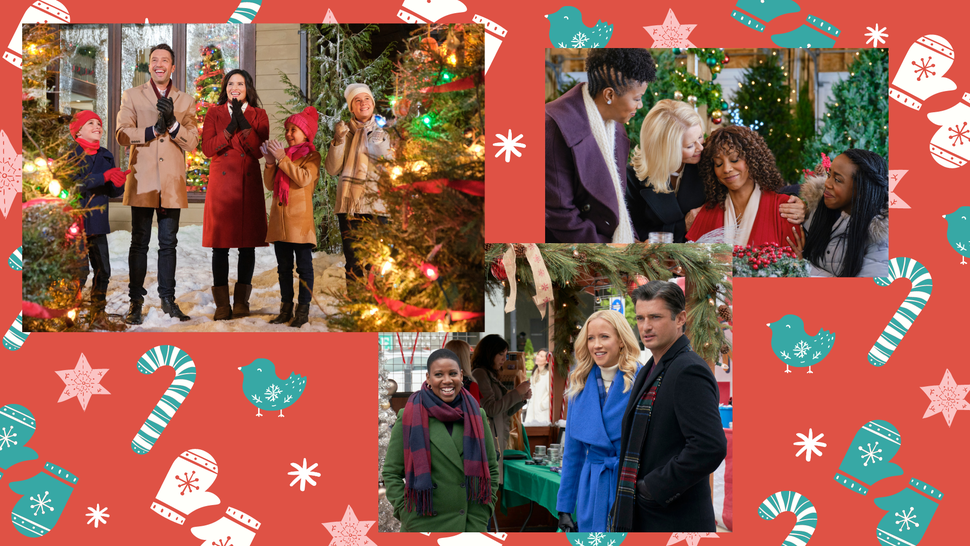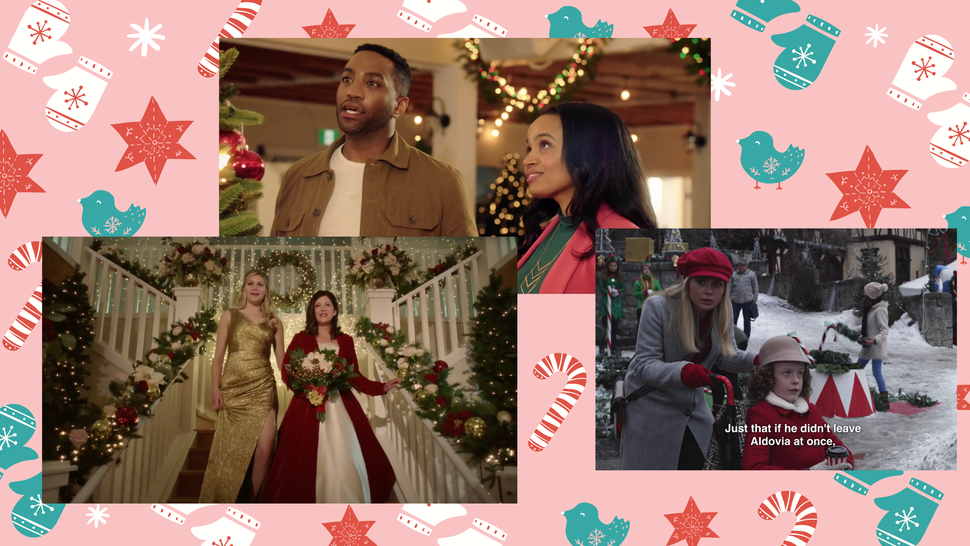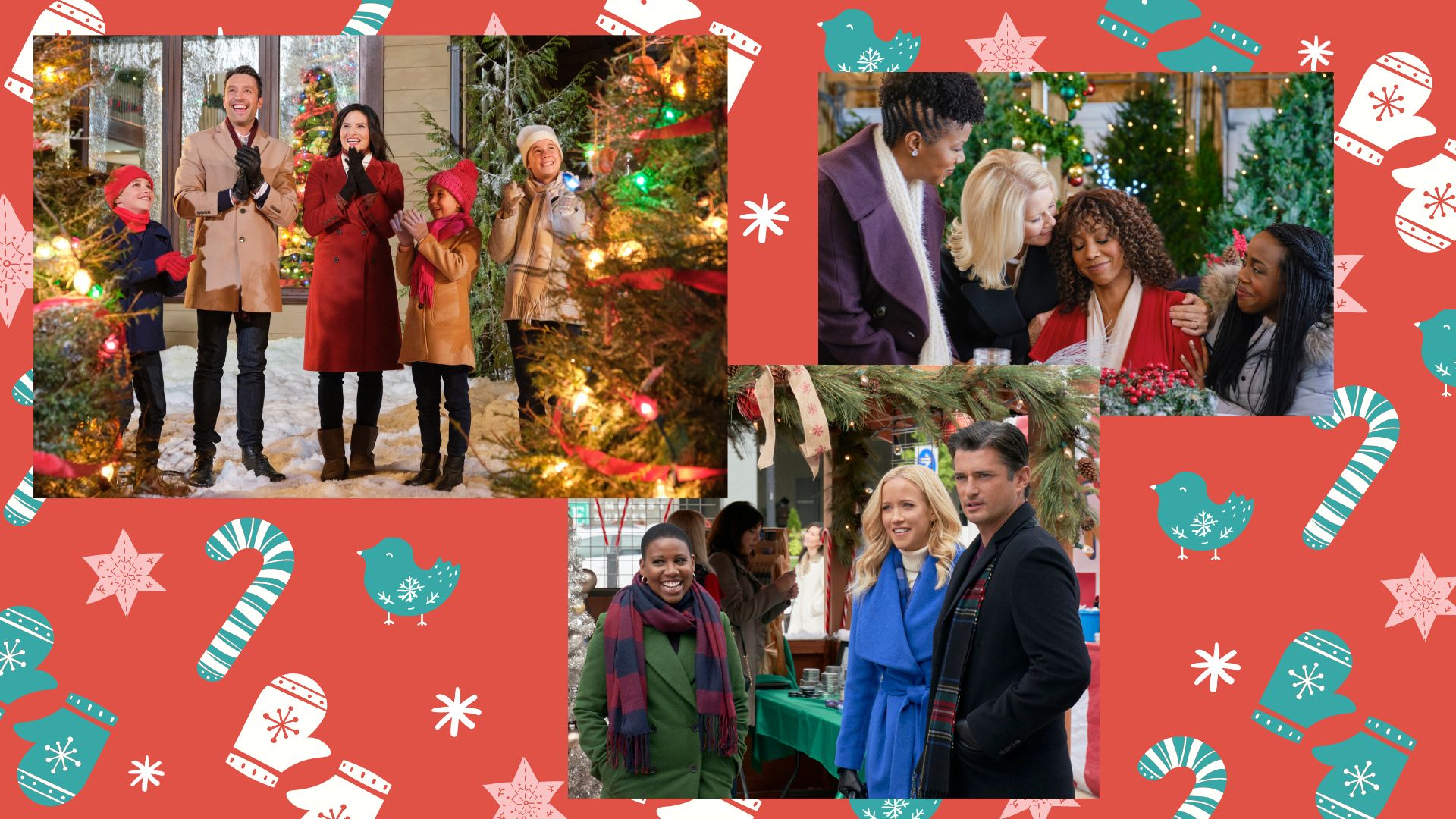TV Holiday Movies Are A Never-Ending Stream Of Red, Green And Whiteness
There’s always a camel peacoat.
Probably a red cashmere sweater, too. Or a green one with a turtleneck. Definitely some tasteful solid-colored sheath dresses, a few cozy plaid scarves, and lots and lots of evergreens … and twinkly lights … and seasonal throw pillows. Is the year 2002? 2012? 2020? Who can say? But this particular aesthetic palette can only mean one thing: You’re watching a made-for-TV holiday movie.
I’ve had a lot of time on my hands and in my apartment over the past few months, which has meant plenty of time to watch more than a healthy amount of holiday-themed films. When you watch a critical mass of these movies, their shared, overarching and largely unchanging aesthetic comes into clear focus. The movies start to bleed into one another, a constant stream of Sad Single Career Women wearing red and green tailored coats paired with plaid scarves over their tasteful workwear, while they decorate their apartments or historic inns or Christmas balls with snowman-covered throw pillows and twinkly lights and vines of holly, somehow still finding time to bake a perfect tray of Christmas cookies.
These movies, with names like “If I Only Had Christmas,” “A Very Crafty Christmas,” “Time For Us To Come Home For Christmas” and “Dear Christmas,” are a staple of the extended American “holiday season,” which essentially stretches from Halloween to New Year’s Eve. In 2020, networks like Lifetime and Hallmark and streaming services like Netflix are releasing more than 100 original holiday movies, the majority of which follow a romantic comedy formula infused with lots of holiday (read: Christmas) spirit.
During a pandemic that has halted and delayed many productions, the made-for-TV holiday movie machine has managed to function smoothly, an apt metaphor for pop-cultural products that exist devoid of political and cultural context.

Christmas in America is as much a capitalist fever dream as it is a familial and religious celebration. Christmas isn’t just a day, it’s a season. And that season has a whole set of accompanying decorations, gift exchanges, foods, outfits and parties.
The holiday movies that populate Lifetime and Hallmark are, as my colleague Claire Fallon wrote in 2018, fundamentally “fairy tales about consumption.” The end result is an aesthetic deemed to have wide commercial appeal; one that resists risk, personality or specificity of any kind, instead leaning into visual cues that signal only the blandest brand of New England, suburban, upper middle-class whiteness — age, geography, race and socioeconomics be damned!
“The Christmas Contract” (2018), about a New York City woman who takes her BFF’s brother home with her to Louisiana for Christmas, has a nearly identical visual vibe to “Let’s Meet Again On Christmas Eve” (2020), about a California event planner who is thrust together with her college ex while planning a Christmas wedding in Connecticut, which has a nearly identical look to “Love At The Christmas Table” (2012), about childhood friends who reunite each year at the children’s Christmas dinner table in a geographically ambiguous snowy suburb. The aesthetic reflects a fundamental terror of change.
In November, Hallmark production designer Shane Meador told House Beautiful that he looked to “traditional New England Christmas decorations,” as well as movies like “The Great Gatsby” and the Christmas decor at Buckingham Palace for inspiration for the set design on this year’s “One Royal Holiday.” (The British monarchy is, not unrelatedly, yet another long-running institution that is resistant to aesthetic change and deeply invested in maintaining its whiteness.)
Lifetime, in particular, has made a concerted effort in the last few years— better late than never — to make holiday movies featuring romantic leads and families of color. This year, the network premiered its first movies centered on an LGBTQ love story (“The Christmas Setup”) and a woman, played by Ali Stroker, who is in a wheelchair (“Christmas Ever After”). But even when holiday romantic comedies feature leads who are not white or straight or able-bodied or Christian, the white hetero aesthetic remains.
2020 was a hellish year for most Americans, full of death and illness and isolation and political upheaval. But in the placid world of made-for-TV holiday movies, class and racial distinctions are collapsed. Everyone can achieve love, success, happiness and fulfillment if they only believe in the Christmas spirit and buy its accessories!
Take “Love, Lights, Hanukkah!,” which premieres on Hallmark this month, an admirable attempt at integrating Jewish people into the Christmas-centric formula of holiday films. In it, a Christmas-obsessed woman discovers that her biological family is Jewish after her adoptive mother passes away and she gets a 23andMe-style DNA test. Presumably, the central theme of the film is Jewishness, explored by way of Hanukkah and random Yiddish phrases. But even the dreidel-obsessed Jewish family in the movie has green boughs draping their front porch fence and staircase and a giant wreath on their door.
In Lifetime’s “The Christmas Yule Blog,” which takes place in the fictional town of Carte de Amor, New Mexico, the only cultural or geographical specificity comes in the form of Ugly Christmas Ponchos as opposed to Ugly Christmas Sweaters. Made-for-TV holiday movies are about consumption, but only a specific type of consumption — one that encourages assimilation toward a white, middle-class standard.
Some of the perpetual 2002 white suburban mom vibe can probably be chalked up to budget. After all, most of these movies are produced quickly and in mass quantities. This means that the sprigs of holly get faker, the tinsel gets chintzier and the A-line ball gowns get less sumptuous. A few of Netflix’s prime holiday offerings, like the “A Christmas Prince” trilogy, “The Princess Switch” duology and “Jingle Jangle” make it clear that a little bit more money goes a long way in making everything look that much glossier.
But in the land of made-for-TV holiday movies, the (mostly) attainable is aspirational. Even in higher-budget holiday movies, specific aesthetic cues still persist: wreaths with gaudy gold ornaments attached, banisters covered in holly, red and green outerwear accessories. Even the Queen of Aldovia in “A Christmas Prince” wears tasteful solid-colored sheath dresses! They just happen to have a few more velvet and pearl accents.

A simple Google search turns up a handful of guides to dressing like your favorite Hallmark movie heroine, filled with culottes from Club Monaco, silver feather necklaces, double-breasted red peacoats from Macy’s, a plethora of peplums, cable-knit beanies and Crocs. These style guides belie the fact that set and costuming choices for most made-for-TV Christmas movies seem designed to sidestep class differences, rendering the personal styling choices of royals in small European principalities nearly identical to the personal styling choices of salt of the earth small-town American locals.
Costumes may signal a shift in a particular character, like when a buttoned-up, pantsuit-wearing, city-based Career Woman lets her guard down and accepts the Christmas Spirit into her life, usually upon return to the small town she grew up in. In such instances, she’ll swap her tailored black or green suit for jeans and a red flannel or green cable-knit sweater. But from movie to movie, the styling is fairly static. The overarching message seems to be that togetherness is akin to sameness; the heroine is only satisfied when she inevitably returns to her roots and her flannels, finds a good-hearted working man to love her, and decorates her Christmas tree.
As cultural shifts occur rapidly in the real world, the world of made-for-TV holiday movies, contained to quaint Christmas-loving towns and sleepy snow-covered suburbs, remains impervious to context. 2020 was a hellish year for most Americans, full of death and illness and isolation and political upheaval. The outgoing president of the United States just spent the last year drumming up racist fervor over the idea that the (white) suburbs ― the very settings of most of these holiday rom-coms ― were on the brink of destruction.
But in the placid world of made-for-TV holiday movies, class and racial distinctions are collapsed. Everyone lives in a big Colonial! Everyone owns a tailored peacoat! Everyone loves a giant Christmas tree covered with sentimental ornaments! Everyone can achieve love, success, happiness and fulfillment if they only believe in the Christmas spirit and buy its accessories!
Christmas in America is a nationwide affair that mashes intangibles like “togetherness” with hyper-capitalist consumption. What is family time in December without wreaths, cashmere knits and plaid? And what kind of endlessly consumable dream would our holiday movies be if we didn’t feel like we could shop straight from their costume closets?
Published at Tue, 08 Dec 2020 10:45:03 +0000

